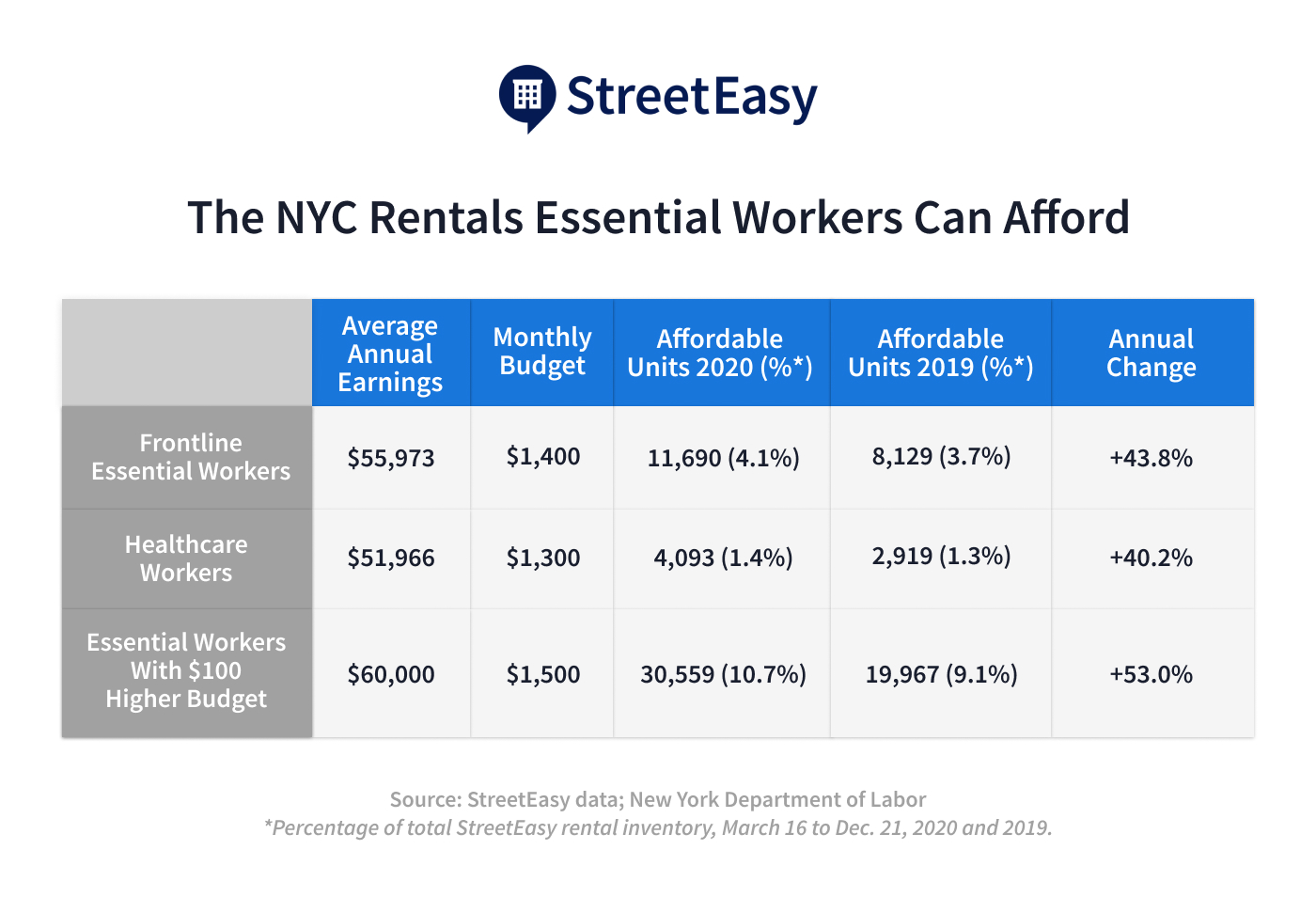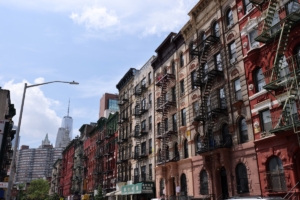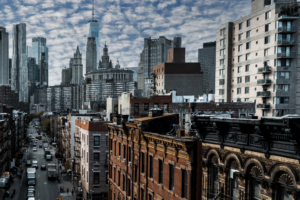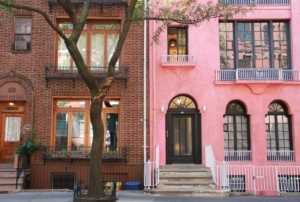New York City’s essential workers power the city day in and day out. And the coronavirus pandemic has only made it clearer how much the city depends on this 25% of its workforce.
But for NYC essential workers, affording city rents on average annual earnings of $55,973 has never been easy. To avoid being “rent burdened,” or spending more than 30% of their monthly income on rent, the average essential worker would need to spend no more than $1,400 per month on housing.
Record rent declines in 2020 have opened up a lot more housing options for this important group. In 2020, the number of StreetEasy-listed apartments affordable to an essential worker increased by 44% from 2019.
That’s 3,561 more homes now affordable to healthcare workers, grocery clerks, public-transit operators, truckers, and postal workers.
Yet to pay for the median market-rate apartment in the city — whose asking price was $2,600 in 2020 — that essential worker would still have to spend 56% of their monthly income. And a whopping 96% of market-rate apartments in NYC last year would have the average essential worker paying more every month than they should.
So, even after the COVID-19 pandemic brought historically large declines in city rents, finding affordable, safe housing remains a tremendous challenge for some of NYC’s most vital residents.

Who Are NYC’s Essential Workers?
New York City’s more than 1 million essential workers are a diverse group in industry and demographics. More than half of essential workers are foreign born; 63% are women; and 75% are people of color. These workers often face heightened challenges as a result of the city’s ongoing affordability crisis. Many lack healthcare, have long commutes, and live in overcrowded conditions.
COVID-19 brought city rents down for the first time since the Great Recession, and caused them to fall at a record pace. By the last quarter of 2020, Manhattan rents had fallen by more than 14% year over year, and Brooklyn and Queens rents had fallen by more than 7%.
But while these declines have certainly expanded the number of units affordable on a nurse’s or building cleaner’s income, they have not significantly improved the affordable housing challenge facing these workers.
Rent Drops Haven’t Offset the Rent Burden for Many
Between March 16 and December 31, 2020, 11,690 apartments on StreetEasy were affordable to the average essential worker without their being rent burdened.
That’s 3,561 more units than were affordable in 2019, but only 4.1% of StreetEasy rental listings total. And while StreetEasy may not capture every single rental listing available in certain NYC neighborhoods, prices on the platform are representative of market rents overall.
Rather than making the city overall more affordable, the impacts of COVID-19 further exacerbated the rent affordability gap. Our latest research found that the pandemic caused rents to fall most in the city’s priciest neighborhoods, and among the most expensive units. Meanwhile, in neighborhoods where many residents are rent burdened, prices hardly changed.
How $100 Less Makes the Home Search 3 Times Harder
Half the essential workers in NYC earn even less than the average annual income of $55,973. For this group, even a small drop in monthly budget can lead to drastically fewer available homes.
For example, the average healthcare worker earns $51,866 annually, according to the New York State Department of Labor. This leads to a monthly budget maximum of $1,300 for rent, just $100 less than the average essential worker overall.
However, this $100 decline in monthly housing budget cuts available options dramatically — from 30,559 affordable apartments in 2020 down to just 4,093 apartments.
The fact that a small difference in monthly budget leads to a third as many housing options shows the severity of the city’s affordability crisis. Apartments under $1,400 are simply very rare, both on StreetEasy and in the New York City market as a whole, leaving many essential workers rent burdened.
Rents Haven’t Fallen Where Essential Workers Live
As our research has shown, pandemic-related rent drops occurred unevenly across the city. While rents have declined the most in Manhattan, New York City’s frontline workers live predominantly in Brooklyn (28%), Queens (22%), and the Bronx (17%). Only 12% live in Manhattan, with 5% in Staten Island. Another 16% live outside the city.
Many of the neighborhoods where essential workers tend to live — Dyker Heights, Sheepshead Bay, East Flatbush, East New York — actually lost affordable housing. East Flatbush saw 24% less rental inventory affordable to the average essential worker in 2020 compared to 2019. In Dyker Heights, that figure was 52%. These neighborhoods are also where residents are most likely to be rent burdened.
Moreover, most of Manhattan’s newly affordable inventory consists of studio apartments. Given that 48% of frontline workers have a child at home, a studio is likely not an ideal option for them.
So while pandemic-driven rent declines have made New York City more affordable to live in, that’s only true in certain places. For the 1 million essential workers who make this city run, last year’s historic drop in rents has put an affordable home only marginally more within reach.
How We Did It
Data on essential worker earnings comes from the New York State Quarterly Census of Employment and Wages. We defined an affordable monthly rent (i.e., non-rent-burdened) as annual income divided by 12 multiplied by 0.3, to reflect that renters who spend more than 30% of their gross income on rent are considered rent-burdened.
This analysis leverages more than a million rental listings on StreetEasy that appeared between March 16 and December 31, 2020. We used an advanced statistical process that builds on the methodology behind the StreetEasy Rent Index. The rent indices are monthly indices that track changes in rent for all residential housing types in New York City on the market, not including public or subsidized housing. These customized rent indices provide an angle on rent growth that is not captured by looking at market medians, and is less susceptible to bias from the types of units available at a given time. Each index uses a repeat-rents method.
To calculate affordability, we used the median market-rate rent across New York City between March 16 and December 31, 2020, for units of 1 to more than 3 bedrooms. We calculated: affordable studios (affordable = salary * .3 divided by 12), 1-bedroom (studio * 1.17), 2-bedroom (studio * 1.32), 3-plus-bedroom (studio * 1.56). The multipliers came from the median asking rents of 1-, 2-, and 3-plus-bedroom apartments compared to studios.









